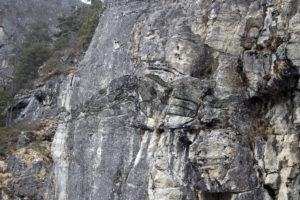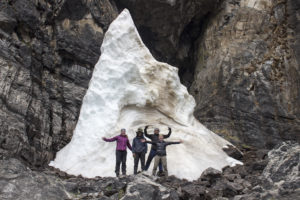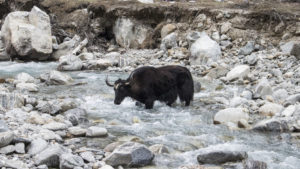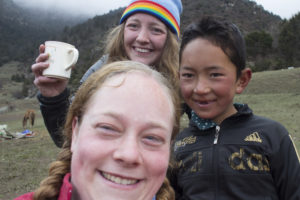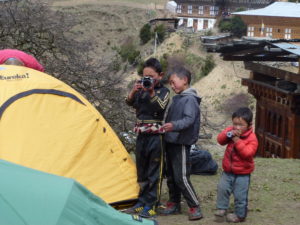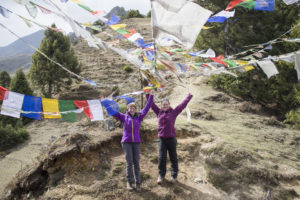Written by Eleni Wood, a PhD student at Open University. You can read more about Eleni’s research here.
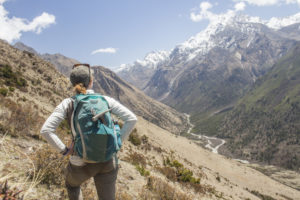
The Masang Kang valley, NW Bhutan, Himalaya. Photo: Stacy Phillips.
Bhutan is an absolute gem of a country, where progress is measured by Gross National Happiness, chili is considered a staple vegetable and the mountains dominate every view. In the late spring of 2017, I and Stacy Philips were lucky enough to call this mountain kingdom our office, as we ventured into the high Himalaya in search of metamorphic rocks and granites.
Ticking the Himalaya off my bucket-list when I first visited Bhutan in 2015 was a dream come true, so being able to come back for a second time I felt so lucky. For my PhD research, I’m investigating a set of deep crustal rocks that have been rapidly exhumed in the high-grade core of the Himalaya defined as the Greater Himalayan Series (GHS). These upper GHS rocks lie above an out-of-sequence structural discontinuity called the Laya Thrust, which is characterised by a package of mylonites several metres thick.
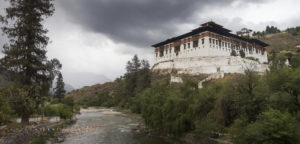
Bhutan has an amazing wealth of history and folklore, many major cities and towns have a Dzong, an ancient fortress that now houses local government and the Buddhist monasteries. Photo: Stacy Phillips.
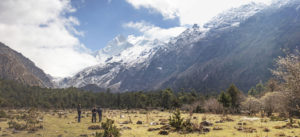
North of Laya, close to one of our camps, we make our way up the valley with stunning views of Masang Kang (6590m). Photo: Stacy Phillips.
The footwall rocks, in the southern area near the settlement of Gasa, are a collection of sillimanite-bearing migmatitic metasediments, orthogneisses, amphibolites, and leucogranites. The hanging wall rocks, on the other hand, preserve a much deeper crustal burial history. In these migmatitic metasediments, there is an abundance of mafic boudins that, where large enough, preserve a granulite core with microtextures that indicate an eclogitic precursor mineralogy. U-Pb dating of these rocks has revealed that they have been exhumed from high-pressure granulite facies depths within the last 15 Ma. But how can we exhume rocks from the deep crust so quickly in the absence of a subduction zone? The aim of this fieldwork was to hunt down rocks from the valleys to the north of Laya to help us try and answer this question.
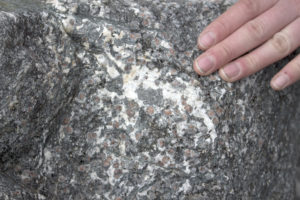
Heavily retrogressed and with very little evidence of granulite mineralogy, this mafic amphibolite, with large garnets, shows interesting melt-rock relationships with large amphibole porphyroblasts. Photo: Stacy Phillips.
On this trip we were lucky enough to find mafic boudins pretty much everywhere we looked for them! What was striking was the shear abundance of mafic rock in these valleys. We found them in all shapes, sizes, and situations: boulders in rivers with near perfect granulite assemblages, retrogressed amphibolites cut by strings of melt, metre sized boudins afloat in coarse pegmatitic granite, melting boudins, boudins 15 metres across, mafic sills continuous over 10’s of metres and, my personal favourite, a sill of boudins, true to their name, looking just like a string of sausages!
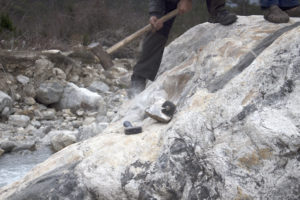
Many of the rocks required a heavy handed approach to sampling, such as this boulder of mafic boudins in entrained in a granitic melt. Photo: Stacy Phillips.
In addition to the vast quantity of mafic rock that will be carted back to the UK, here are a few other things we picked up along the way:
1. It takes a really really loooong time to get anywhere in Bhutan – Despite the country being the size of Switzerland, it also has the steepest elevation profile from highest to lowest point of any country in the world (so I have been told). This crazy gradient manifests itself in some pretty jaw-droppingly steep terrain, which makes getting around a bit tricky, to say the least. Enjoy bumping along a rocky track for days on end and trekking up steep hills to reach your field site? If so Bhutan is the country for you.
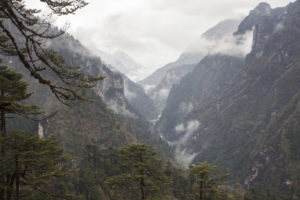
The lush forests above Gasa and the valley and route north to the high settlement of Laya. Photo: Stacy Phillips.
2. Road construction is happening EVERYWHERE – There was so much progress made on the roads between 2015 – 2017, the Dochula pass has transformed from a 4-hour bone shaking experience to a 2-hour cruise with glorious views included. The new road from Gasa towards the remote settlement of Laya, on the other hand, is a vertigo-inducing trail that suffers from frequent landslides. That’s not to mention the need for careful navigation around the team of JCB-driving, dynamite-wielding excavators that are intent on blasting their way through the mountainside.
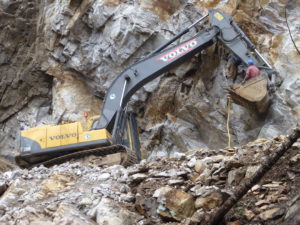
Bhutanese road construction delivering new outcrop daily… you can’t spot the 3rd construction worker in the bucket from this angle!
3. Road construction can be a geologist’s friend – We really can’t complain about all this road construction, when we’re the first geologists to set eyes on some of the freshest road-cuts in the Himalaya!
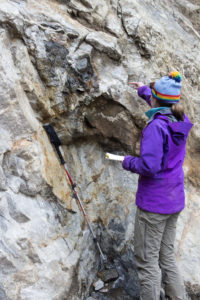
Examining interesting granite-mafic relationships along a fresh road cut… maybe we were the first geologists to set eyes on this one? Photo: Stacy Phillips.
4. A good team makes the trip – Our in-country guides and team were invaluable and amazing people! Not only do they make the trip so much more than it would be without them, they can get you out of sticky situations – which is great when your permits to pass checkpoints are stamped “2016” and not “2017”. On some days, I feel they went beyond the line of duty, following us into the steep rhododendron thickets with our sledgehammer. If you’re reading this guys, thank you so much!
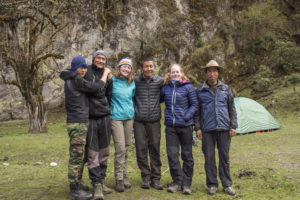
Making camp with our amazing team! Left to right: Pema, Dechen, me, Kinley, Stacy & Gau. Photo: Stacy Phillips.
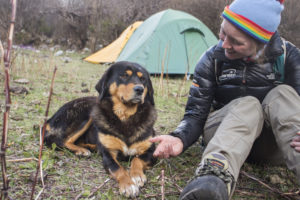
Our honorary team member for the two weeks is unimpressed with the hand bearing no food. Photo: Stacy Phillips.
5. Always say ‘yes’ to new things (except noodle soup) – hot stone baths, karaoke, visiting Dzongs (amazing fortresses!) – ALWAYS say yes to all of these things. Just don’t accept the delicious but dangerous spicy noodle soup.
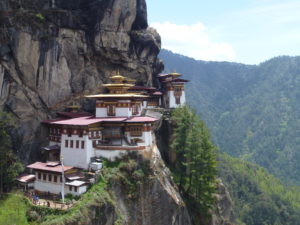
Paro Takstang, or the Tiger’s Nest perched atop Greater Himalayan Series gneiss!
6. Don’t bother hiking through rhododendron forests, do walk upstream – in reference to point 4. Don’t do it. You won’t find good rocks. You will get caught on every twig and bush. Stick to the streams. Much better rocks and beautiful waterfalls.
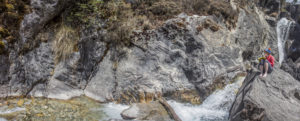
Waterfalls proving that they are not only beautiful, but also geologically interesting. Photo: Stacy Phillips.
7. The wildlife is wild! – Birds, the elusive takins, snow leopard scat, following fresh bear footprints and being chased uphill by yak herder’s dogs; it’s never a dull day in Bhutan!
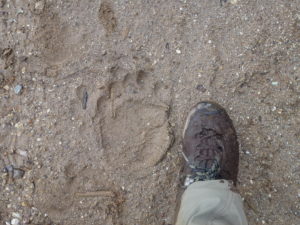
Following bear tracks on the back down the mountains, apparently, they’ve developed a taste for rice these days…
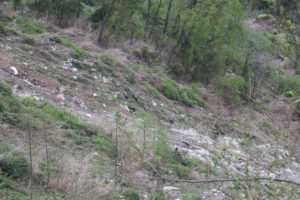
Spot the herd of takin on their way up to higher grazing in the summer months. Photo: Stacy Phillips.
But whatever you do…
- Take photos EVERYWHERE – Stacy and her new friends definitely did!
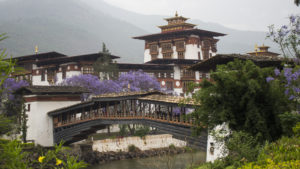
Punakha Dzong, amongst the Jacaranda blossom, standing proud at the confluence of the ‘male’ and ‘female’ rivers. Photo: Stacy Phillips.
![]() This work is licensed under a Creative Commons Attribution-NonCommercial-ShareAlike 4.0 International License.
This work is licensed under a Creative Commons Attribution-NonCommercial-ShareAlike 4.0 International License.

